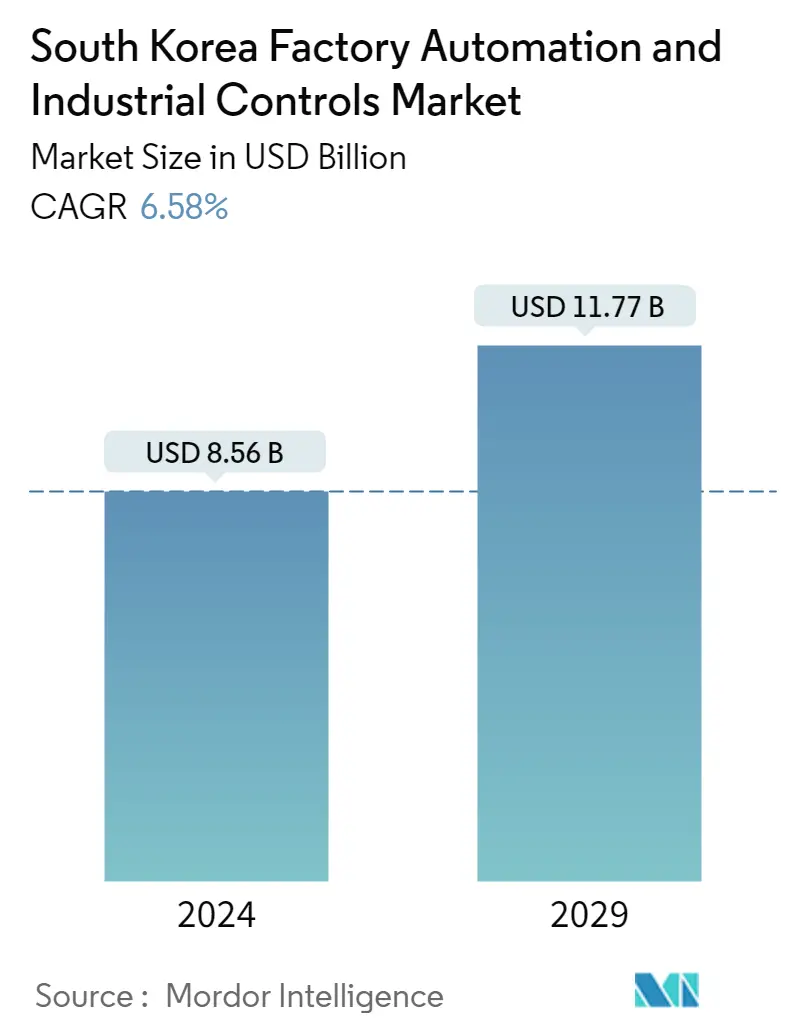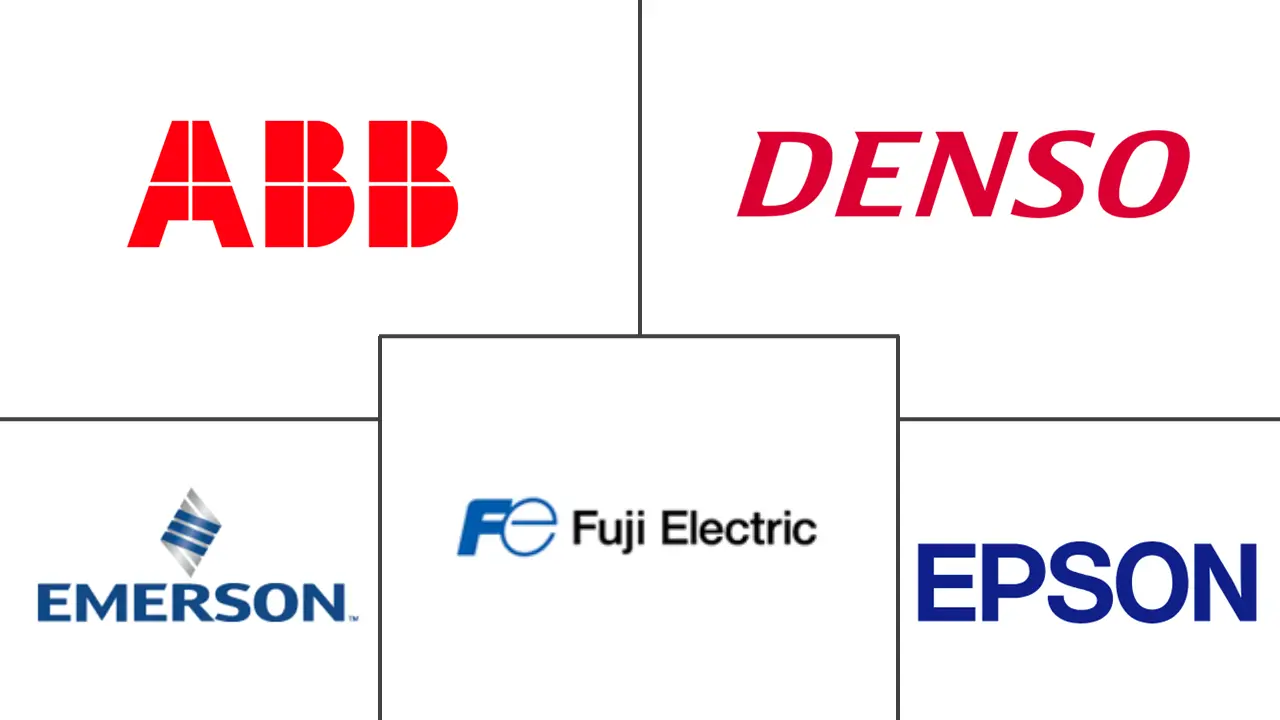Market Size of South Korea Factory Automation and Industrial Controls Industry

| Study Period | 2019 - 2029 |
| Base Year For Estimation | 2023 |
| Market Size (2024) | USD 8.56 Billion |
| Market Size (2029) | USD 11.77 Billion |
| CAGR (2024 - 2029) | 6.58 % |
| Market Concentration | Low |
Major Players
*Disclaimer: Major Players sorted in no particular order |
South Korea Factory Automation & Industrial Controls Market Analysis
The South Korea Factory Automation and Industrial Controls Market size is estimated at USD 8.56 billion in 2024, and is expected to reach USD 11.77 billion by 2029, growing at a CAGR of 6.58% during the forecast period (2024-2029).
Due to the rising demand for PLC, SCADA, and industrial robots across various end-user sectors, the market is expanding.
The numbers for the South Korean FAICS market are derived by evaluating contributions of various product types, such as presence sensing safety sensors, emergency stop devices, safety controllers/modules, safety mats, programmable logic controllers (PLC), human-machine interface (HMI), machine vision systems, industrial robotics, sensors and transmitters, switches, relays, and industrial power supplies.
Automation of manufacturing processes has various benefits, such as effortless monitoring, waste reduction, and production speed. This technology provides customers with improved quality with standardization and dependable products in less time and cost.
Moreover, the introduction of always-on-e-commerce fueled the demand for faster responses and the need to manage a more significant number of stock-keeping units (SKUs) with fewer errors; warehouses and fulfillment centers need to scale up and meet standards of a smart, efficient, and automated factory solutions.
Furthermore, huge capital is required to set up and install industrial robots in the factory. The average cost of a fixed robot ranges between USD 60,000-140,000, whereas the average cost of a mobile robot varies between USD 25,000-40,000. These high costs discourage factory operators from choosing high-end industrial robots, which challenges the market's growth.
The COVID-19 pandemic complicated the situation of automation adoption in various sectors. It changed the standard operating procedure by bringing in unique challenges of social distancing and contactless operation. Organizations were forced to limit their workforce and deal with the increasing demand. Social distancing measures had a more significant impact as they led manufacturers to restructure operations to rely more on robotics in the region. Overall, the COVID-19 pandemic slowed down the market but improved and steadily expanded in the post-pandemic era.
South Korea Factory Automation & Industrial Controls Industry Segmentation
Industrial control and factory automation are rising trends in the manufacturing industry, which provide smart manufacturing infrastructure. Industrial control and factory automation facilitate cost efficiency, product quality, standardized manufacturing, reliability, and flexibility in manufacturing.
The South Korean automation industry was revolutionized by combining the digital and physical aspects of manufacturing to deliver optimum performance. Furthermore, the focus on achieving zero waste production and a shorter time to market augmented the market's growth. The market defines revenues generated from selling and installing different factory automation and industrial control systems products in the region.
The market size was derived for the South Korean FAICS market by evaluating contributions of various product types, such as presence sensing safety sensors, emergency stop devices, safety controllers/modules, safety mats, programmable logic controllers (PLC), human-machine interface (HMI), machine vision systems, industrial robotics, sensors and transmitters, switches, relays, and industrial power supplies. The South Korean FAICS market also covers various end-user industries in the region, such as automotive, semiconductor, manufacturing, oil and gas, chemical and petrochemical, food and beverage, and power and utilities. The market sizes and forecasts regarding value (USD million) for all the above segments are provided.
| By Product Type | ||||||
| Presence Sensing Safety Sensors | ||||||
| Emergency Stop Devices | ||||||
| Safety Controllers/Modules | ||||||
| Safety Mats | ||||||
| Programmable Logic Controllers (PLC) | ||||||
| Human Machine Interface (HMI) | ||||||
| Machine Vision Systems | ||||||
| Industrial Robotics | ||||||
| Sensors and Transmitters | ||||||
| ||||||
| Relays | ||||||
| Industrial Power Supplies |
| By End-user | |
| Automotive | |
| Semiconductor | |
| Manufacturing | |
| Oil and Gas | |
| Chemical and Petrochemical | |
| Food and Beverage | |
| Power and Utilities | |
| Other End-users |
South Korea Factory Automation and Industrial Controls Market Size Summary
The South Korean factory automation and industrial controls market is experiencing significant growth, driven by the increasing demand for advanced technologies such as PLC, SCADA, and industrial robots across various sectors. This expansion is fueled by the need for enhanced manufacturing efficiency, waste reduction, and improved product quality. The rise of e-commerce has further accelerated the demand for automated solutions in warehouses and fulfillment centers, necessitating smarter and more efficient factory operations. However, the high capital investment required for industrial robots poses a challenge to market growth, as many operators are deterred by the substantial costs associated with both fixed and mobile robots. The COVID-19 pandemic initially slowed the adoption of automation, but it ultimately led to a shift towards increased reliance on robotics to meet social distancing requirements and manage workforce limitations.
The market is characterized by the presence of major global players such as Denso Korea Corporation, ABB Korea Co. Ltd, and Emerson Electric Korea Ltd, who are actively investing in strategic partnerships and product innovations to enhance their market presence. The proliferation of IoT devices in South Korea, with millions of subscriptions, underscores the growing integration of automation and remote control services. This trend is further supported by advancements in data management strategies that optimize decision-making and operational efficiency. The food and beverage industry, in particular, is leveraging automated machine safety systems to improve production flexibility and ensure regulatory compliance. Companies like Rockwell Automation and MFDS are introducing solutions to streamline operations and enhance product quality. Overall, the South Korean factory automation and industrial controls market is poised for continued growth, driven by technological advancements and strategic industry initiatives.
South Korea Factory Automation and Industrial Controls Market Size - Table of Contents
-
1. MARKET INSIGHTS
-
1.1 Market Overview
-
1.2 Industry Attractiveness - Porters Five Forces Analysis
-
1.2.1 Bargaining Power of Suppliers
-
1.2.2 Bargaining Power of Buyers
-
1.2.3 Threat Of New Entrants
-
1.2.4 Threat of Substitute Products
-
1.2.5 Intensity of Competitive Rivalry
-
-
1.3 Industry Value Chain Analysis
-
1.4 Assessment of Impact of COVID-19 on the Market
-
-
2. MARKET SEGMENTATION
-
2.1 By Product Type
-
2.1.1 Presence Sensing Safety Sensors
-
2.1.2 Emergency Stop Devices
-
2.1.3 Safety Controllers/Modules
-
2.1.4 Safety Mats
-
2.1.5 Programmable Logic Controllers (PLC)
-
2.1.6 Human Machine Interface (HMI)
-
2.1.7 Machine Vision Systems
-
2.1.8 Industrial Robotics
-
2.1.9 Sensors and Transmitters
-
2.1.10 Switches
-
2.1.10.1 Safety Switches
-
2.1.10.2 Limit Switches
-
2.1.10.3 Pushbutton Switches
-
2.1.10.4 DIP Switches
-
-
2.1.11 Relays
-
2.1.12 Industrial Power Supplies
-
-
2.2 By End-user
-
2.2.1 Automotive
-
2.2.2 Semiconductor
-
2.2.3 Manufacturing
-
2.2.4 Oil and Gas
-
2.2.5 Chemical and Petrochemical
-
2.2.6 Food and Beverage
-
2.2.7 Power and Utilities
-
2.2.8 Other End-users
-
-
South Korea Factory Automation and Industrial Controls Market Size FAQs
How big is the South Korea Factory Automation and Industrial Controls Market?
The South Korea Factory Automation and Industrial Controls Market size is expected to reach USD 8.56 billion in 2024 and grow at a CAGR of 6.58% to reach USD 11.77 billion by 2029.
What is the current South Korea Factory Automation and Industrial Controls Market size?
In 2024, the South Korea Factory Automation and Industrial Controls Market size is expected to reach USD 8.56 billion.
Factory Automation and Industrial Control Market in South Korea Report Snapshots
- Factory Automation and Industrial Control Market in South Korea Market Size
- Factory Automation and Industrial Control Market in South Korea Market Share
- Factory Automation and Industrial Control Market in South Korea Market Trends
- Factory Automation and Industrial Control Market in South Korea Companies

